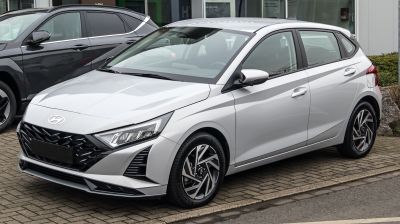Hyundai i20

- Year: 2008
- Manufacturer: Hyundai Motor Company
- Body Type: hatchback
- Status: in_production
- Predecessor: Hyundai Getz, Hyundai Accent hatchback
The Hyundai i20 is a supermini car manufactured by Hyundai since 2008. Across its generations, the i20 has consistently offered a compelling blend of practicality and affordability. Known for its relatively spacious interior for its class, the i20 boasts a comfortable ride and decent fuel economy, making it a popular choice for city driving and smaller families. Depending on the trim level and generation, features can range from basic necessities to more advanced infotainment systems, safety features like electronic stability control and multiple airbags, and various engine options, often prioritizing efficiency over outright power. The i20 has undergone several redesigns, constantly evolving its styling and technology to remain competitive in a crowded market segment, emphasizing its position as a reliable and well-equipped everyday vehicle.
Generations
First generation (PB; 2008)
The Hyundai i20's first generation (PB, 2008-2014) marked Hyundai's entry into the B-segment European market with a model designed specifically to compete against established rivals. This five-door hatchback featured a relatively contemporary design for its time, offering a practical and stylish option for young families and urban dwellers. Engine choices focused on fuel efficiency and affordability, reflecting the ongoing trend toward smaller, more economical vehicles. The interior was functional, if not particularly luxurious, prioritizing practicality and space optimization. Although its technological features were not cutting-edge, the i20 offered a solid blend of value, efficiency, and reliability, aiming to establish a strong foothold in the competitive European market. While not necessarily groundbreaking, the first-generation i20 successfully laid the groundwork for Hyundai's continued expansion and success in the European market.
Second generation (GB/IB; 2014)
The Hyundai i20's second generation (GB/IB), launched in 2014, represented a significant step up from its predecessor. This model featured a more mature and refined design, moving away from the somewhat quirky styling of the first generation. The interior saw a considerable improvement in material quality and build, offering a more upmarket feel than before. Engine options ranged from efficient petrol and diesel units, catering to a variety of needs and budgets. While not revolutionary in terms of technology, it offered features like Bluetooth connectivity and improved safety features compared to its forbearer, solidifying its position as a competitive option in the B-segment hatchback market. The platform was also engineered for improved handling and ride comfort, addressing some criticisms leveled at the earlier model. Its success laid the groundwork for the even more advanced third generation.
Third generation (BC3/BI3; 2020)
The Hyundai i20's third generation (BC3/BI3), arriving in 2020, marked a substantial leap forward. This iteration boasted a sharper, more dynamic exterior design, integrating Hyundai's evolving “Sensuous Sportiness” design language. Inside, the cabin showcased a clear improvement in terms of technology and refinement. A larger touchscreen infotainment system with smartphone integration became standard across many trims, while advanced driver-assistance systems (ADAS) like lane-keeping assist and autonomous emergency braking were made more readily available. The engine choices were optimized for fuel efficiency and performance, with more powerful engine options alongside eco-friendly hybrid choices in certain markets. Build quality was further enhanced, and the overall driving experience benefited from improved chassis tuning, resulting in a more agile and composed feel on the road. This model cemented the i20's status as a leading contender within its class.

